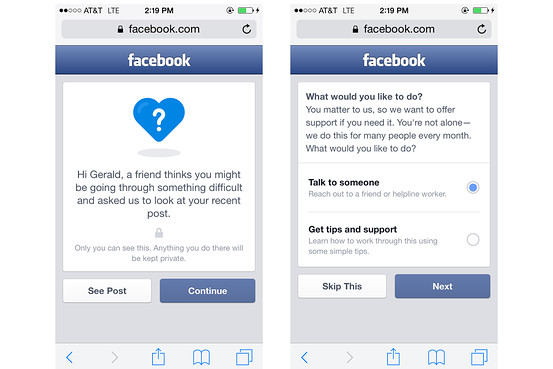By Susan Richardson, March 05 2015
Last week, global social media leader Facebook announced that it will roll out a new feature designed to enable friends to help friends struggling with suicidal thoughts. It stems from the knowledge that Facebook users often share deep, personal thoughts on the channel, and sometimes, this includes thoughts of despair or hurt.
The effort is in partnership with our friends at Forefront: Innovations in Suicide Prevention, an interdisciplinary organization based in the University of Washington’s School of Social Work, as well Now Matters Now, the National Suicide Prevention Lifeline, and Save.org.
How It Works
If a Facebook user posts something to the channel that signals that they may harm themselves or are in need of help, his or her Facebook friend now has the ability to “report” it for the social networking service. A team at Facebook will review the post for legitimacy and, if pursued, Facebook will offer to connect the person in need with a helpline worker, as well as recommend resources to learn how to get help.

The new suite of Facebook tools were created with expert input from the mental health organizations listed above, as well as from people who have lived through self-injury or self-hurt.
Why It’s Important
The suicide prevention tools offered by Facebook will reach the channels 1.39 billion users worldwide. Not only does this bring mental health to the forefront as an important discussion as a whole, but it also identifies the need for mental health professionals to think more critically about the intersection of mental health and social media. It begs the question: How can we more effectively reach teens where they already are to improve mental health outcomes?
A recent study from BI Intelligence reports that Facebook remains the top social network for teens, with nearly half of teen Facebook users say they're using the site more than last year.
That being said, we’re also seeing smaller, growing social media channels emerge among teens. On Tumblr—a microblogging platform—46 percent of users are between the ages of 16 and 24. That demographic also dominates on Snapchat, a photo messaging app.
We admire Facebook’s initiative to partner with leading mental health organizations to develop a tool that may help our teens improve mental health, and encourage leaders to continue keeping their fingers on the pulse of social media tools and techniques that teens are using. Understanding their behaviors will help us develop strategies to more effectively reach teens and deliver support.
Topics: Adolescent Mental Health
Updated: March 05 2015
